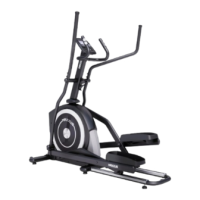Preparation Before Training
Before you begin training, ensure that both your training device and your body are in optimal condition. It's important to
prepare your body for training. If you haven't engaged in endurance training for a while, it is advisable to consult your GP
and undergo a fitness check-up. Additionally, discuss your training goals with them as they can provide valuable advice
and information. This is particularly important for individuals who are over 35 years old, have issues with overweight, or
experience heart or circulatory system problems.
Training Plan
An essential aspect of effective, goal-oriented, and motivating training is to have a well-defined training plan. Incorporate
your fitness training as an integral part of your daily routine. Without a structured plan, training can easily interfere with
regular commitments or consistently be postponed to an unspecified time. Whenever possible, create a long-term monthly
plan rather than planning day-to-day or week-to-week. A comprehensive training plan should also include elements of
motivation and distraction during training sessions. An ideal form of distraction is to watch TV while training, as it provides
both visual and auditory diversion. Ensure that you set realistic targets and reward yourself accordingly. For example, aim
to lose 1 or 2 kilograms in four weeks or increase your training time by 10 minutes within two weeks. Once you achieve
your targets, reward yourself with a favorite meal that you haven't allowed yourself until then.
Warm-Up Before Training
Prior to your training session, warm up on your training device for a minimum of 3-5 minutes at the lowest resistance setting.
This will effectively prepare your body for the upcoming physical exertion during training.
.
Cool-Down After Training
After completing your training session, it is important not to immediately stop using the training device. Similar to the warm-up
stage, continue exercising for 3-5 minutes at the lowest resistance setting to cool down your body. Additionally, after training,
make sure to stretch your muscles thoroughly.
VFront Thigh Muscles
Stand near a wall or use your training device for support. Place your right hand against the wall or
on the training device. Bend your left knee and lift your left foot backwards so you can hold it with
your left hand. Ensure that your knee is pointing straight down to the floor. Slowly pull your leg
backwards until you feel a light pulling in your thigh muscles. Hold this position for about 10 to
15 seconds. Release your foot and place it back on the floor. Repeat the exercise with your right
leg.
Inner Thigh Muscles Exercise
Sit on the floor and pull the soles of your feet together in front of you, raising your knees slightly.
Grasp the upper sides of your feet and place your elbows on your thighs. Press your thighs down
towards the floor with your arms until you feel a light pulling in your thigh muscles. Hold this
position for 10 to 15 seconds while keeping your upper body straight. Release the pressure from
your thighs and slowly stretch out your legs to the front. Stand up slowly and steadily.
Legs, Calves, and Buttocks Exercise
Sit on the floor. Stretch out your right leg and bend your left leg, placing the sole of your foot on
your right thigh. Bend your upper body forward, reaching out with your right hand to touch your
right toes. Hold this position for 10 to 15 seconds. Release your toes and slowly sit up straight
again. Repeat the exercise with your left leg.
Leg and Lower Back Muscles Exercise
Sit on the floor with your legs stretched out in front of you. Reach forward with your hands and
try to grasp the tips of your toes with both hands. Hold this position for 10 to 15 seconds. Release
your toes and slowly and steadily sit back up straight again.
Training Recommendations
26

